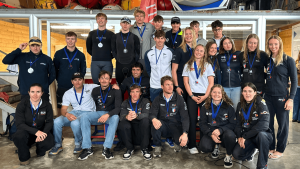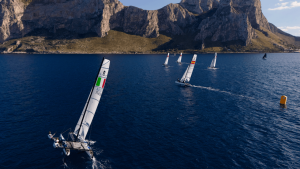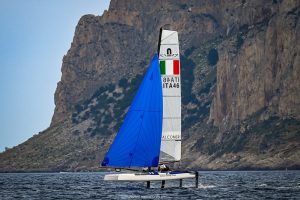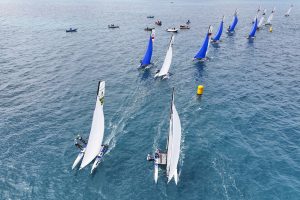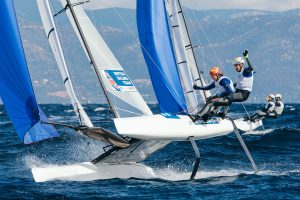All three scheduled races were cancelled today due to severe wind conditions with gusts of wind of almost 35 knots and two meters’ waves. Austrian Thomas Zajac, who is sixth in the classification of the open championship after sailing six races with his partner Tanja Frank, summarized the feeling of the fleet: “Under these conditions, I think that to have a fleet race with so many Nacra 17 boats would be dangerous.”
In fact, in this new Olympic class, which will debut in Rio 2016, the crews usually wear a helmet. These catamarans can sometimes reach speeds up to 65 km/h; speeds never seen before in Olympic sailing classes, as well as the helmets.
Some of the 84 athletes competing in Barcelona this week made the most of the day by training in the gym of the Barcelona International Sailing Center, a modern training centre where everything is designed for the sailor’s comfort. The BISC stands out for its direct access to the race course, the huge esplanade for boats and other facilities such as a hotel, meeting rooms and chill-out areas, in addition to the gym. British Ben Saxton, since day one leader of the European Championship with Nicola Groves, highlighted that “the facilities are really nice here at the BISC. Good changing rooms, good showers… and those things make a difference. The slip ways are easy to launch, lots of space and there is no sand, so it is great, everything is nice. It`s our first time sailing in Barcelona and is really nice, I`ll be back”.
British Ben Saxton, since day one leader of the European Championship with Nicola Groves, highlighted that “the facilities are really nice here at the BISC. Good changing rooms, good showers… and those things make a difference. The slip ways are easy to launch, lots of space and there is no sand, so it is great, everything is nice. It`s our first time sailing in Barcelona and is really nice, I`ll be back”.
The gym is one of the busiest areas. And the thing is that, with the Nacra 17, the sailors, and especially the females, have acquired the status of athletes. “In Olympic sailing it is unusual, but in this class the girls are true athletes -said Spanish Tara Pacheco-. We must be very strong, do a lot of training in the gym and also a lot of weight control. I used to weigh 55 kilos and now I`m 63kg … People always talks about how hard it is to lose weight, but gaining it is very hard too. We burn 4,000 calories a day, and always a little more during a competition with the stress. I usually eat five to six times a day, all very healthy and well planned, rice or pasta without sauce and combined with some protein”.
Besides being strong, they need to be agile and quick in the manoeuvres, have a good technique, and also to be able to read the race course and dominate the strategy. These are qualities that have, for example, three female Olympic medallists, who are sailing in the Nacra 17 European. Greek Sofia Bekatorou, gold in Athens 2004 in 470 and bronze in Beijing 2008 in Yngling, is an idol in her country. Brazilian Isabel Swan also has a bronze medal from Beijing, in this case in the 470 class, while Australian Nina Curtis was silver in London 2012 in Match Race.
Another feature that defines this class which will debut in Rio 2016 is that the crew consists of one male and one female. There are few sports where mixed teams compete. “In rhythmic gymnastics, skating, tennis… very few among the Olympic sports- mentioned Pacheco. Is there a reason for that?”
British Ben Saxton and Nicola Groves are at the top of the Europeans. In second place and tied up on points with the leaders, there are Australians Darren Bundock and Nina Curtis. French Franck Cammas and Sophie de Turckheim complete the provisional podium after six races.
Tomorrow, Thursday October 1st, the Nacra 17 European will resume at the Barcelona International Sailing Center. According to the forecast the wind should ease off, so the Race Committee has scheduled four races. The European competition will run until Saturday, October 3rd.



